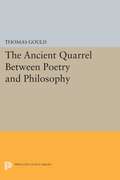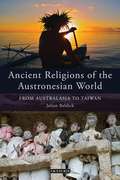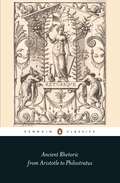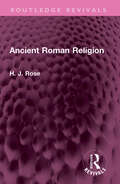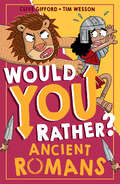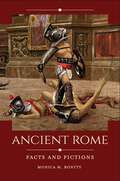- Table View
- List View
Ancient Philosophy: A Very Short Introduction (Very Short Introductions)
by Julia AnnasVery Short Introductions: Brilliant, Sharp, Inspiring The tradition of ancient philosophy is a long, rich and varied one. Julia Annas gives a succinct account of ancient Greco-Roman philosophy, emphasizing its freshness and variety of themes, and its approach of lively discussion and argument. Getting away from the presentation of ancient philosophy as a succession of Great Thinkers, the book gives readers a sense of the freshness and liveliness of ancient philosophy, and of its wide variety of themes and styles. This new edition has been fully updated to reflect updates in the field, with new illustrations and up to date further reading to allow further exploration of the field. The text has been expanded and modernized to be more comprehensive and accessible to the general reader, as well as exploring the relation of the tradition of ancient Greco-Roman philosophy to other traditions and to us. ABOUT THE SERIES: The Very Short Introductions series from Oxford University Press contains hundreds of titles in almost every subject area. These pocket-sized books are the perfect way to get ahead in a new subject quickly. Our expert authors combine facts, analysis, perspective, new ideas, and enthusiasm to make interesting and challenging topics highly readable.
Ancient Philosophy: A Very Short Introduction (Very Short Introductions)
by Julia AnnasVery Short Introductions: Brilliant, Sharp, Inspiring The tradition of ancient philosophy is a long, rich and varied one. Julia Annas gives a succinct account of ancient Greco-Roman philosophy, emphasizing its freshness and variety of themes, and its approach of lively discussion and argument. Getting away from the presentation of ancient philosophy as a succession of Great Thinkers, the book gives readers a sense of the freshness and liveliness of ancient philosophy, and of its wide variety of themes and styles. This new edition has been fully updated to reflect updates in the field, with new illustrations and up to date further reading to allow further exploration of the field. The text has been expanded and modernized to be more comprehensive and accessible to the general reader, as well as exploring the relation of the tradition of ancient Greco-Roman philosophy to other traditions and to us. ABOUT THE SERIES: The Very Short Introductions series from Oxford University Press contains hundreds of titles in almost every subject area. These pocket-sized books are the perfect way to get ahead in a new subject quickly. Our expert authors combine facts, analysis, perspective, new ideas, and enthusiasm to make interesting and challenging topics highly readable.
The Ancient Phonograph (Zone Bks.)
by Shane ButlerLong before the invention of the phonograph, the written word was unrivaled as a medium of the human voice. In The Ancient Phonograph, Shane Butler takes us back to an age, long before Edison, when writing itself was still relatively new. He meticulously reconstructs a series of Greek and Roman soundscapes ranging from Aristotle to Augustine.Here the real voices of tragic actors, ambitious orators, and singing emperors blend with the imagined voices of lovesick nymphs, tormented heroes, and angry gods. The resonant world we encounter in ancient sources is at first unfamiliar, populated by texts that speak and sing, often with no clear difference between the two. But Butler discovers a commonality that invites a deeper understanding of why voices mattered then, and why they have mattered since.With later examples that range from Petrarch to Puccini, Mozart to Jimi Hendrix, Butler offers an ambitious attempt to rethink the voice — as an anatomical presence, a conceptual category, and a source of pleasure and wonder. He carefully and critically assesses the strengths and limits of recent theoretical approaches to the voice by Adriana Cavarero and Mladen Dolar and makes a rich and provocative range of ancient material available for the first time to students and scholars in voice studies, sound studies, and media theory. The Ancient Phonograph will appeal not only to classicists but to anyone interested in the verbal arts — literature, oratory, song — and the nature of aesthetic experience.
The Ancient Quarrel Between Poetry and Philosophy
by Thomas GouldAffecting audiences with depictions of suffering and injustice is a key function of tragedy, and yet it has long been viewed by philosophers as a dubious enterprise. In this book Thomas Gould uses both historical and theoretical approaches to explore tragedy and its power to gratify readers and audiences. He takes as his starting point Plato's moral and psychological objections to tragedy, and the conflict he recognized between "poetry"--the exploitation of our yearning to see ourselves as victims--and "philosophy"--the insistence that all good people are happy. Plato's objections to tragedy are shown to be an essential feature of Socratic rationalism and to constitute a formidable challenge even today. Gould makes a case for the rightness and psychological necessity of violence and suffering in literature, art, and religion, but he distinguishes between depictions of violence that elicit sympathy only for the victims and those that cause us to sympathize entirely with the perpetrators. It is chiefly the former, Gould argues, that fuel our responses not only to true tragedy but also to religious myths and critical displays of political rage.Originally published in 1990.The Princeton Legacy Library uses the latest print-on-demand technology to again make available previously out-of-print books from the distinguished backlist of Princeton University Press. These editions preserve the original texts of these important books while presenting them in durable paperback and hardcover editions. The goal of the Princeton Legacy Library is to vastly increase access to the rich scholarly heritage found in the thousands of books published by Princeton University Press since its founding in 1905.
Ancient Relativity: Plato, Aristotle, Stoics, and Sceptics
by Matthew DuncombeIdeas about relativity underlie much ancient Greek philosophy, from Protagorean relativism, to Plato's theory of Forms, Aristotle's category scheme, and relational logic. In Ancient Relativity Matthew Duncombe explores how ancient philosophers, particularly Plato, Aristotle, the Stoics, and Sextus Empiricus, understood the phenomenon and how their theories of relativity affected, and were affected by, their broader philosophical outlooks. He argues that ancient philosophers shared a close-knit family of views referred to as 'constitutive relativity', whereby a relative is not simply linked by a relation but is constituted by it. Plato exploits this view in some key arguments concerning the Forms and the partition of the soul. Aristotle adopts the constitutive view in his discussions of relativity in Categories 7 and the Topics and retains it in Metaphysics Delta 15. Duncombe goes on to examine the role relativity plays in Stoic philosophy, especially Stoic physics and metaphysics, and the way Sextus Empiricus thinks about relativity, which does not appeal to the nature of relatives but rather to how we conceive of things as correlative.
Ancient Religions (Blackwell Ancient Religions Ser.)
by Sarah Iles JohnstonReligious beliefs and practices, which permeated all aspects of life in antiquity, traveled well-worn routes throughout the Mediterranean: itinerant charismatic practitioners journeying from place to place peddled their skills as healers, purifiers, cursers, and initiators; and vessels decorated with illustrations of myths traveled with them. New gods encountered in foreign lands by merchants and conquerors were sometimes taken home to be adapted and adopted. This collection of essays by a distinguished international group of scholars, drawn from the groundbreaking reference work Religions of the Ancient World, offers an expansive, comparative perspective on this complex spiritual world.
Ancient Religions: A Guide (Harvard University Press Reference Library)
by Sarah Iles JohnstonReligious beliefs and practices, which permeated all aspects of life in antiquity, traveled well-worn routes throughout the Mediterranean: itinerant charismatic practitioners journeying from place to place peddled their skills as healers, purifiers, cursers, and initiators; and vessels decorated with illustrations of myths traveled with them. New gods encountered in foreign lands by merchants and conquerors were sometimes taken home to be adapted and adopted. This collection of essays by a distinguished international group of scholars, drawn from the groundbreaking reference work Religions of the Ancient World, offers an expansive, comparative perspective on this complex spiritual world.
Ancient Religions, Modern Politics: The Islamic Case in Comparative Perspective
by Michael CookWhy does Islam play a larger role in contemporary politics than other religions? Is there something about the Islamic heritage that makes Muslims more likely than adherents of other faiths to invoke it in their political life? If so, what is it? Ancient Religions, Modern Politics seeks to answer these questions by examining the roles of Islam, Hinduism, and Christianity in modern political life, placing special emphasis on the relevance—or irrelevance—of their heritages to today's social and political concerns.Michael Cook takes an in-depth, comparative look at political identity, social values, attitudes to warfare, views about the role of religion in various cultural domains, and conceptions of the polity. In all these fields he finds that the Islamic heritage offers richer resources for those engaged in current politics than either the Hindu or the Christian heritages. He uses this finding to explain the fact that, despite the existence of Hindu and Christian counterparts to some aspects of Islamism, the phenomenon as a whole is unique in the world today. The book also shows that fundamentalism—in the sense of a determination to return to the original sources of the religion—is politically more adaptive for Muslims than it is for Hindus or Christians.A sweeping comparative analysis by one of the world's leading scholars of premodern Islam, Ancient Religions, Modern Politics sheds important light on the relationship between the foundational texts of these three great religious traditions and the politics of their followers today.
Ancient Religions, Modern Politics: The Islamic Case in Comparative Perspective (PDF)
by Michael CookWhy does Islam play a larger role in contemporary politics than other religions? Is there something about the Islamic heritage that makes Muslims more likely than adherents of other faiths to invoke it in their political life? If so, what is it? Ancient Religions, Modern Politics seeks to answer these questions by examining the roles of Islam, Hinduism, and Christianity in modern political life, placing special emphasis on the relevance—or irrelevance—of their heritages to today's social and political concerns.Michael Cook takes an in-depth, comparative look at political identity, social values, attitudes to warfare, views about the role of religion in various cultural domains, and conceptions of the polity. In all these fields he finds that the Islamic heritage offers richer resources for those engaged in current politics than either the Hindu or the Christian heritages. He uses this finding to explain the fact that, despite the existence of Hindu and Christian counterparts to some aspects of Islamism, the phenomenon as a whole is unique in the world today. The book also shows that fundamentalism—in the sense of a determination to return to the original sources of the religion—is politically more adaptive for Muslims than it is for Hindus or Christians.A sweeping comparative analysis by one of the world's leading scholars of premodern Islam, Ancient Religions, Modern Politics sheds important light on the relationship between the foundational texts of these three great religious traditions and the politics of their followers today.
Ancient Religions of the Austronesian World: From Australasia to Taiwan (International Library of Ethnicity, Identity and Culture)
by Julian BaldickAustronesia is the vast oceanic region which stretches from Madagascar to Taiwan to New Zealand. Encompassing both scattered archipelagos and major landmasses, Austronesia – derived from the Latin australis, 'southern', and Greek nesos, 'island' – is used primarily as a linguistic term, designating a family of languages spoken by peoples with a shared heritage. Julian Baldick, a celebrated historian of ancient religion, here argues that the diverse inhabitants of the Philippines, Taiwan, Indonesia, New Guinea and Oceania show a common inheritance that extends beyond language. This commonality is found above all in mythology and ritual, which reach back to an ancient, prehistoric past. From around 1250 BCE the original proto-Oceanic speakers migrated eastwards from southeast Asia. Navigating by the sun, the stars, bird flight, the swells of the sea and cloud-swathed mountain islands, Austronesian voyagers used canoes and outriggers to settle on new territories. They developed a unified pattern of religion characterised by mortuary rites, headhunting and agrarian rituals of the annual calendar, culminating in a post-harvest festival often sexual in nature. This unique overview of Austronesian belief and tradition will be essential reading for students of religion, prehistory and anthropology.
Ancient Rhetoric: From Aristotle to Philostratus
by Thomas HabinekClassical rhetoric is one of the earliest versions of what is today known as media studies. It was absolutely crucial to life in the ancient world, whether in the courtroom, the legislature, or on ceremonial occasions, and was described as either the art of the persuasion or the art of speaking well. This anthology brings together all the most important ancient writings on rhetoric, including works by Cicero, Aristotle, Quintilian and Philostratus. Ranging across such themes as memory, persuasion, delivery and style, it provides a fascinating introduction to classical rhetoric and will be an invaluable sourcebook for students of the ancient world.
Ancient Roman Literary Gardens: Gender, Genre, and Geopoetics
by K. Sara MyersGardens are not central in Latin literature, but usually somewhere off to the side, as was often the real garden. They appear, however, in some form in nearly all literary genres of Latin literature--history, satire, epigrams, epics, letters, lyric poetry, elegies, and novels--and often edge their way into larger socio-economic and political discussions about Roman identity, gender, wealth, and land use. Through an analysis of ancient garden studies and close readings of major Latin texts from the first centuries BCE and CE, K. Sara Myers examines the function and representation of garden descriptions in the work of a broad range of Roman authors, such as Cicero, Catullus, Vergil, Varro, Horace, Ovid, Petronius, Columella, Statius, and Pliny the Elder and Younger. While most of the sources in this study are poetic and their gardens fictional, it is still important to situate these works in their cultural and historical contexts. By understanding how to interpret the importance of these spaces in the literature in which they appear, readers will not only better comprehend the aesthetic and ethical values of the work in question, but they will also gain a better insight into ancient Roman attitudes toward gender, art, and human relationships with nature. Myers shows how some Romans constructed the garden as a space under male control: Men are cultivators, while women are cultivated. Literary gardens can symbolize a range of positive masculine ideals and identities for elite men--from the rustic farmer to the philosopher--but can also represent unmanly luxury and leisure. Women in gardens are usually sexualized, depicted as virginal or sexually transgressive, especially when they attempt to express ownership over these spaces. In almost all these texts, the artificial and artistic arrangement of the raw material of nature invites self-reflexivity, which Myers calls "geopoetics," or a "poetics of the earth."
Ancient Roman Literary Gardens: Gender, Genre, and Geopoetics
by K. Sara MyersGardens are not central in Latin literature, but usually somewhere off to the side, as was often the real garden. They appear, however, in some form in nearly all literary genres of Latin literature--history, satire, epigrams, epics, letters, lyric poetry, elegies, and novels--and often edge their way into larger socio-economic and political discussions about Roman identity, gender, wealth, and land use. Through an analysis of ancient garden studies and close readings of major Latin texts from the first centuries BCE and CE, K. Sara Myers examines the function and representation of garden descriptions in the work of a broad range of Roman authors, such as Cicero, Catullus, Vergil, Varro, Horace, Ovid, Petronius, Columella, Statius, and Pliny the Elder and Younger. While most of the sources in this study are poetic and their gardens fictional, it is still important to situate these works in their cultural and historical contexts. By understanding how to interpret the importance of these spaces in the literature in which they appear, readers will not only better comprehend the aesthetic and ethical values of the work in question, but they will also gain a better insight into ancient Roman attitudes toward gender, art, and human relationships with nature. Myers shows how some Romans constructed the garden as a space under male control: Men are cultivators, while women are cultivated. Literary gardens can symbolize a range of positive masculine ideals and identities for elite men--from the rustic farmer to the philosopher--but can also represent unmanly luxury and leisure. Women in gardens are usually sexualized, depicted as virginal or sexually transgressive, especially when they attempt to express ownership over these spaces. In almost all these texts, the artificial and artistic arrangement of the raw material of nature invites self-reflexivity, which Myers calls "geopoetics," or a "poetics of the earth."
Ancient Roman Religion (Routledge Revivals)
by H. J. RoseFirst published in 1949, Ancient Roman Religion is an introduction to some of the most outstanding features of the complicated religion, or rather series of religions, which flourished in Rome between the earliest recoverable ages of her long history and the close of the classical epoch. This book will be of interest students of religion, literature and history.
Ancient Roman Religion (Routledge Revivals)
by H. J. RoseFirst published in 1949, Ancient Roman Religion is an introduction to some of the most outstanding features of the complicated religion, or rather series of religions, which flourished in Rome between the earliest recoverable ages of her long history and the close of the classical epoch. This book will be of interest students of religion, literature and history.
The Ancient Romans: History and Society from the Early Republic to the Death of Augustus
by Matthew Dillon Lynda GarlandThis textbook provides comprehensive coverage of the political, military, and social history of ancient Rome from the earliest days of the Republic to its collapse and the subsequent foundations of the empire established by Augustus prior to his death in AD 14. Interspersed through the discussion of the political history of the period are crucial chapters on all aspects of Roman culture, including women, religion, slavery and manumission, overseas conquests and their impact, and life in the city of Rome, giving students a full understanding of republican society, culture, and politics. With over 130 maps, illustrations, and photographs, The Ancient Romans is lavishly illustrated, with a particular emphasis on coins as a valuable historical resource. It also closely references the authors’ sourcebook, Ancient Rome: Social and Historical Documents from the Early Republic to the Death of Augustus, second edition, allowing students to engage with the documentary evidence and written sources in a deep and meaningful way. The Ancient Romans: History and Society from the Early Republic to the Death of Augustus is an indispensable resource for undergraduate students of the Roman Republic and its society and culture, as well as offering a comprehensive and compelling introduction for the interested reader.
The Ancient Romans: History and Society from the Early Republic to the Death of Augustus
by Matthew Dillon Lynda GarlandThis textbook provides comprehensive coverage of the political, military, and social history of ancient Rome from the earliest days of the Republic to its collapse and the subsequent foundations of the empire established by Augustus prior to his death in AD 14. Interspersed through the discussion of the political history of the period are crucial chapters on all aspects of Roman culture, including women, religion, slavery and manumission, overseas conquests and their impact, and life in the city of Rome, giving students a full understanding of republican society, culture, and politics. With over 130 maps, illustrations, and photographs, The Ancient Romans is lavishly illustrated, with a particular emphasis on coins as a valuable historical resource. It also closely references the authors’ sourcebook, Ancient Rome: Social and Historical Documents from the Early Republic to the Death of Augustus, second edition, allowing students to engage with the documentary evidence and written sources in a deep and meaningful way. The Ancient Romans: History and Society from the Early Republic to the Death of Augustus is an indispensable resource for undergraduate students of the Roman Republic and its society and culture, as well as offering a comprehensive and compelling introduction for the interested reader.
Ancient Romans (Would You Rather? #3)
by Clive GiffordWould you rather row a Roman vessel or be a chariot racer? Eat stuffed dormice or parrot heads? Only you can decide!
Ancient Rome: The Rise And Fall Of An Empire
by Simon BakerThis is the story of the greatest empire the world has ever known. Simon Baker charts the rise and fall of the world's first superpower, focusing on six momentous turning points that shaped Roman history. Welcome to Rome as you've never seen it before - awesome and splendid, gritty and squalid. From the conquest of the Mediterranean beginning in the third century BC to the destruction of the Roman Empire at the hands of barbarian invaders some seven centuries later, we discover the most critical episodes in Roman history: the spectacular collapse of the 'free' republic, the birth of the age of the 'Caesars', the violent suppression of the strongest rebellion against Roman power, and the bloody civil war that launched Christianity as a world religion. At the heart of this account are the dynamic, complex but flawed characters of some of the most powerful rulers in history: men such as Pompey the Great, Julius Caesar, Augustus, Nero and Constantine. Putting flesh on the bones of these distant, legendary figures, Simon Baker looks beyond the dusty, toga-clad caricatures and explores their real motivations and ambitions, intrigues and rivalries. The superb narrative, full of energy and imagination, is a brilliant distillation of the latest scholarship and a wonderfully evocative account of Ancient Rome.
Ancient Rome: Facts and Fictions (Historical Facts and Fictions)
by Monica M. BonttyThis book shares little-known facts from and excerpts of primary source documents to correct popular misconceptions about Ancient Rome and to show how those misconceptions became widespread.Roman personalities and history have always had a larger-than-life profile in American popular culture, but most people think of this ancient civilization as merely decadent, cruel, and elitist. Most of our stereotypical conceptions of the empire and its people, however, are wrong. This book corrects popular misconceptions about the ancient Roman world, thus making ancient history relevant and accessible to modern readers and allowing modern critics of American politics and society to draw accurate comparisons.Each chapter discusses how a particular misconception developed, spread, and evolved into what we now believe to be the historical truth. Topics discussed include crucifixion, the destruction of Carthage, Julius Caesar's last words, and Roman hygiene. Excerpts from primary source documents provide evidence of both the rise of the historical fictions and the truths behind the myths.
Ancient Rome: Facts and Fictions (Historical Facts and Fictions)
by Monica M. BonttyThis book shares little-known facts from and excerpts of primary source documents to correct popular misconceptions about Ancient Rome and to show how those misconceptions became widespread.Roman personalities and history have always had a larger-than-life profile in American popular culture, but most people think of this ancient civilization as merely decadent, cruel, and elitist. Most of our stereotypical conceptions of the empire and its people, however, are wrong. This book corrects popular misconceptions about the ancient Roman world, thus making ancient history relevant and accessible to modern readers and allowing modern critics of American politics and society to draw accurate comparisons.Each chapter discusses how a particular misconception developed, spread, and evolved into what we now believe to be the historical truth. Topics discussed include crucifixion, the destruction of Carthage, Julius Caesar's last words, and Roman hygiene. Excerpts from primary source documents provide evidence of both the rise of the historical fictions and the truths behind the myths.
Ancient Rome: Social and Historical Documents from the Early Republic to the Death of Augustus (Routledge Sourcebooks for the Ancient World)
by Matthew Dillon Lynda GarlandIn this second edition, Ancient Rome presents an extensive range of material, from the early Republic to the death of Augustus, with two new chapters on the Second Triumvirate and The Age of Augustus. Dillon and Garland have also included more extensive late Republican and Augustan sources on social developments, as well as further information on the Gold Age of Roman literature. Providing comprehensive coverage of all important documents pertaining to the Roman Republic and the Augustan age, Ancient Rome includes: source material on political and military developments in the Roman Republic and Augustan age (509 BC – AD 14) detailed chapters on social phenomena, such as Roman religion, slavery and freedmen, women and the family, and the public face of Rome clear, precise translations of documents taken not only from historical sources but also from inscriptions, laws and decrees, epitaphs, graffiti, public speeches, poetry, private letters and drama concise up-to-date bibliographies and commentaries for each document and chapter a definitive collection of source material on the Roman Republic and early empire. Students of ancient Rome and classical studies will find this new edition invaluable at all levels of study.
Ancient Rome: Social and Historical Documents from the Early Republic to the Death of Augustus (Routledge Sourcebooks for the Ancient World)
by Matthew Dillon Lynda GarlandIn this second edition, Ancient Rome presents an extensive range of material, from the early Republic to the death of Augustus, with two new chapters on the Second Triumvirate and The Age of Augustus. Dillon and Garland have also included more extensive late Republican and Augustan sources on social developments, as well as further information on the Gold Age of Roman literature. Providing comprehensive coverage of all important documents pertaining to the Roman Republic and the Augustan age, Ancient Rome includes: source material on political and military developments in the Roman Republic and Augustan age (509 BC – AD 14) detailed chapters on social phenomena, such as Roman religion, slavery and freedmen, women and the family, and the public face of Rome clear, precise translations of documents taken not only from historical sources but also from inscriptions, laws and decrees, epitaphs, graffiti, public speeches, poetry, private letters and drama concise up-to-date bibliographies and commentaries for each document and chapter a definitive collection of source material on the Roman Republic and early empire. Students of ancient Rome and classical studies will find this new edition invaluable at all levels of study.
Ancient Rome (Waldorf Education Resources Ser.)
by Charles KovacsThis book, for use by Steiner-Waldorf teachers, includes stories of the founding of Rome, the early battles with Carthage and Hannibal, Julius Caesar and the conquests of Gaul and Britain, Antony and Cleopatra, and the decline and fall under the Huns and the beginning of the Dark Ages._x000D_It is recommended for Steiner-Waldorf curriculum Class 6 (age 11-12).


